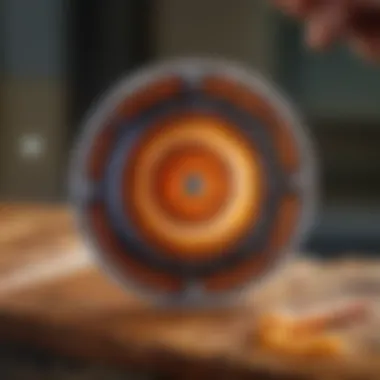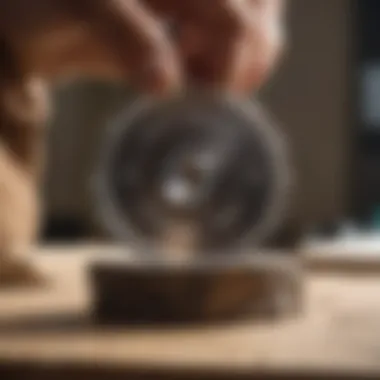Unveiling the Intricacies of Lapidary Trim Saw Blades: An In-Depth Guide


Rock and Fossil Identification
In the realm of lapidary trim saw blades, understanding the types of rocks and fossils that one may encounter is crucial. Different rocks and fossils possess unique characteristics, which can help collectors identify them accurately. Utilizing the appropriate tools for identification is paramount in this process, as it allows collectors to discern the subtle differences between various specimens.
Collecting Tips and Techniques
When it comes to collecting rocks and fossils, adopting best practices is essential to ensure a successful and rewarding experience. Knowing how to locate prime collecting sites can significantly enhance the chances of finding valuable specimens. Additionally, understanding how to safely extract these specimens is key to preserving their integrity and beauty.
Preservation and Display
Preserving rocks and fossils requires skill and attention to detail. By employing proper techniques, collectors can prolong the lifespan of their specimens and maintain their aesthetic appeal. Implementing suitable storage methods is critical in preventing deterioration and damage. For those looking to showcase their collection, creative display ideas can elevate the visual impact of the rocks and fossils.
Geological Insights
Exploring the geological aspects of rocks and fossils unveils a fascinating journey into the Earth's history. Understanding geological formations and processes sheds light on how these specimens came to be. Delving into the historical significance of rocks and fossils provides a broader perspective on their importance. Examining notable discoveries in the field offers insights into the scientific advancements made through the study of rocks and fossils.
Introduction to Lapidary Trim Saw Blades
Lapidary trim saw blades serve as indispensable tools in the realm of rock and fossil cutting, facilitating precise cuts and enhancing overall lapidary experiences. Understanding the nuances of trim saw blades is crucial for rock and fossil collectors seeking to elevate their craftsmanship. These blades are not mere accessories but precision instruments that can significantly impact the quality of cuts and the final outcome of lapidary projects. Proper knowledge about trim saw blades empowers enthusiasts to make informed decisions, ultimately leading to improved cutting precision and efficiency.
Understanding the Role of Trim Saw Blades
The Significance of Precision Cutting
Precision cutting is paramount in lapidary work as it dictates the accuracy and quality of the final cut pieces. Trim saw blades engineered for precision cutting offer minimal vibration and consistent performance, ensuring clean and smooth cuts on various materials. The ability of these blades to maintain precise dimensions during cutting enables lapidary artists to achieve intricate shapes and designs with utmost accuracy. Additionally, precision cutting with trim saw blades minimizes material wastage, making them a preferred choice for rock and fossil collectors aiming for perfection in their craft.
Materials That Benefit from Trim Saws
Certain materials, such as tough gemstones and dense fossils, greatly benefit from the use of trim saw blades designed for hard materials. These specialized blades possess the hardness and durability required to cut through challenging materials effectively, reducing chipping and ensuring clean edges. The superior cutting performance of trim saw blades on hard materials enhances efficiency and precision in shaping gemstones and fossils. Rock and fossil collectors dealing with a diverse range of materials can rely on trim saw blades to achieve consistent and high-quality cuts, making them invaluable tools in lapidary work.


Key Components of Lapidary Trim Saw Blades
Blade Material Composition
The composition of trim saw blades plays a pivotal role in their performance and longevity. Blades crafted from high-quality materials such as diamond or carbide exhibit exceptional hardness and resistance to wear, making them suitable for prolonged cutting sessions without losing sharpness. The composition of these blades ensures superior cutting performance and durability, essential for enduring the demands of lapidary work. Understanding the significance of blade material composition aids rock and fossil collectors in selecting blades optimized for their specific cutting needs, promoting efficiency and precision in their projects.
Tooth Design and Configuration
The design and configuration of the teeth on trim saw blades influence their cutting efficiency and versatility. Different tooth designs cater to specific cutting requirements, ranging from fine detail work to rapid material removal. Additionally, tooth configurations determine the chip load capacity of the blades, impacting their cutting speed and surface finish quality. Rock and fossil collectors can choose from a variety of tooth designs and configurations to suit their cutting preferences, ensuring optimal performance and precise results in their lapidary endeavors.
Types of Trim Saw Blades
Diamond Rim Blades
Diamond rim blades stand out for their exceptional cutting performance on hard and abrasive materials like gemstones and minerals. These blades feature diamond-coated edges that deliver precise and clean cuts while maintaining sharpness over extended use. Rock and fossil collectors engaged in cutting challenging materials benefit from the superior hardness and durability of diamond rim blades, achieving professional-quality results in their lapidary projects.
Carbide Tipped Blades
Carbide tipped blades combine the strength of carbide with the toughness of steel, providing a versatile cutting solution for various lapidary materials. The carbide tips enhance cutting efficiency and wear resistance, ensuring prolonged blade life and consistent performance. With the ability to cut through both soft and hard materials efficiently, carbide tipped blades are favored by rock and fossil collectors requiring flexibility and durability in their cutting tools.
Notched Rim Blades
Notched rim blades feature specialized notches on their edges, enhancing coolant flow and debris removal during cutting. These blades excel in maintaining a clean cutting path by preventing overheating and material buildup, resulting in smoother cuts and reduced blade wear. Rock and fossil collectors working with heat-sensitive materials or intricate designs benefit from the efficient cooling and debris clearance provided by notched rim blades. Investing in these specialized blades ensures optimal cutting performance and longevity in lapidary applications.
Selecting the Right Trim Saw Blade
Selecting the right trim saw blade is a crucial aspect when delving into lapidary work. The blade choice significantly impacts cutting precision and efficiency. Rock and fossil collectors must carefully consider several key elements when choosing a blade, such as material compatibility and blade size.
Factors to Consider When Choosing a Blade


Material Compatibility
Material compatibility plays a pivotal role in the performance of trim saw blades. The type of material being cut influences the effectiveness and longevity of the blade. For instance, diamond rim blades are ideal for cutting hard materials like gems and quartz due to their durability and precision. On the other hand, carbide-tipped blades are more suitable for softer stones like agate. Understanding material compatibility ensures optimal cutting results and minimizes blade wear.
Blade Size and Arbor
The blade size and arbor size are critical considerations for rock and fossil collectors. Selecting the appropriate blade size ensures compatibility with the cutting material and the saw equipment. Moreover, matching the arbor size to the saw machine guarantees a secure fit, preventing vibrations and enhancing cutting stability. Choosing the right combination of blade size and arbor size is essential for achieving precise cuts and maximizing the blade's lifespan.
Optimizing Efficiency and Cutting Performance
Optimizing the efficiency and cutting performance of trim saw blades involves strategic adjustments in tension, blade speed, and coolant usage.
Tension and Blade Speed
Maintaining optimal tension and adjusting blade speed according to the material being cut are key factors in enhancing cutting efficiency. Adequate tension improves blade stability and reduces the risk of deflection, ensuring accurate cuts. Similarly, adapting blade speed to the material's hardness minimizes overheating and prolongs blade sharpness. Finding the right balance between tension and blade speed is crucial for achieving smooth and consistent cutting results.
Coolant Usage
Proper coolant usage significantly impacts cutting performance by dissipating heat and reducing friction during the cutting process. Using coolant helps prevent blade overheating, extends blade life, and enhances cutting precision. Different types of coolants, such as water-based or oil-based solutions, offer varying benefits depending on the material being cut. Implementing effective coolant strategies improves overall cutting efficiency and ensures a superior finish.
Maintenance and Care of Trim Saw Blades
In the realm of lapidary trim saw blades, the significance of maintenance and care cannot be overstated. Proper maintenance ensures longevity and optimal performance of these precision cutting tools. By adhering to a regular maintenance schedule, users can prevent wear and tear, maintain cutting precision, and prolong the lifespan of their blades. Additionally, effective maintenance practices contribute to safe operation and enhanced cutting efficiency, factors crucial for a seamless lapidary experience.
Cleaning and Lubrication Practices
Removing Resin Build-Up:
One crucial aspect of blade maintenance is the removal of resin build-up. Resin accumulation on the saw blades can impede cutting performance, leading to inaccurate cuts and potential damage to the material being worked on. By regularly cleaning blades to remove resin build-up, lapidary enthusiasts ensure consistent cutting precision and extend the longevity of their blades. This practice not only enhances cutting efficiency but also minimizes the risk of blade overheating, ensuring a smooth and controlled cutting process. Effective removal of resin build-up is a cornerstone of blade maintenance for lapidary enthusiasts seeking optimal performance from their trim saw blades.


Preventative Maintenance Tips:
Preventative maintenance tips play a crucial role in preserving the quality and functionality of trim saw blades. By following preventative maintenance measures, users can proactively address potential issues and safeguard the performance of their blades over time. These tips encompass various aspects such as proper storage, regular cleaning, and inspection of blades for any signs of wear or damage. Implementing preventative maintenance tips not only safeguards the investment in trim saw blades but also enhances cutting precision, ensuring consistent and reliable performance during lapidary projects.
Storage Recommendations
Ideal Storage Conditions:
The storage of trim saw blades is a critical aspect of maintenance that directly impacts their longevity and cutting performance. Ideal storage conditions involve keeping blades in a dry and clean environment to prevent rust, corrosion, or damage. Storing blades in a secure location away from excessive moisture or temperature fluctuations preserves their sharpness and integrity, contributing to prolonged usability and cutting precision. By adhering to ideal storage conditions, lapidary enthusiasts can ensure that their trim saw blades remain in optimal condition for extended periods, ready for efficient cutting tasks.
Protecting Blade Teeth:
Protecting the teeth of trim saw blades is essential for maintaining their sharpness and cutting efficiency. Since the teeth are critical for the cutting process, safeguarding them from damage or wear is imperative. Implementing measures such as using blade guards during storage, handling blades carefully to avoid impacts, and avoiding contact with hard surfaces can prevent premature wear of the teeth. Protecting blade teeth not only enhances the lifespan of trim saw blades but also ensures consistent and precise cutting performance, vital for achieving desired results in lapidary projects.
Utilizing Trim Saw Blades Effectively
In the realm of lapidary work, the effective utilization of trim saw blades holds immense significance. Rock and fossil collectors understand the pivotal role played by these tools in cutting and shaping precious stones and minerals with utmost precision. Achieving optimal results requires a keen focus on specific elements such as blade tension and speed, ensuring the blades function at their best capacity. By paying attention to the compatibility of materials and selecting the right blade size and arbor for the task at hand, enthusiasts can elevate their lapidary experience to new heights. The efficiency and cutting performance of trim saw blades are directly tied to the user's ability to harness these tools effectively.
Safety Precautions and Best Practices
Eye Protection and Dust Control
Eye protection and dust control are paramount considerations when working with lapidary trim saw blades. The eyes are sensitive to debris and particles that may result from cutting stones, making quality eye protection crucial to prevent any potential damage. Proper eye protection not only safeguards the user's vision but also ensures uninterrupted workflow by reducing the risk of eye discomfort or injuries. Dust control mechanisms further enhance the safety measures by minimizing inhalation of harmful particles, promoting a healthier working environment for lapidary enthusiasts.
Correct Cutting Techniques
In the context of utilizing trim saw blades effectively, mastering correct cutting techniques is indispensable. Precision cutting requires a thorough understanding of blade positioning, pressure application, and the mechanics of the sawing process. Implementing correct cutting techniques not only enhances the quality of the finished product but also prolongs the lifespan of the blades. By adopting these techniques, rock and fossil collectors can achieve smooth, uniform cuts while minimizing wastage and errors. Incorporating correct cutting techniques into the workflow is integral to optimizing the performance of trim saw blades.
Troubleshooting Common Blade Issues
Blade Wobbling
Blade wobbling can be a common challenge encountered during lapidary work, impacting cutting precision and overall efficiency. This issue often stems from misalignment, a loose arbor, or improper tension settings, leading to erratic movements during operation. Resolving blade wobbling requires meticulous attention to detail, including adjusting the blade's position, securing the arbor, and calibrating tension levels correctly. By addressing blade wobbling promptly, users can restore stability to the cutting process and ensure consistent results with their trim saw blades.
Uneven Cutting
Uneven cutting poses a significant obstacle to achieving the desired outcomes in lapidary work. This issue can result from blade wear, insufficient lubrication, or inconsistencies in material hardness. Identifying the root cause of uneven cutting is crucial to implementing targeted solutions effectively. Adjusting cutting speed, reviewing blade condition, and optimizing lubrication practices are key steps in alleviating the challenges associated with uneven cutting. By troubleshooting this common blade issue systematically, rock and fossil collectors can enhance the precision and quality of their cutting projects.







